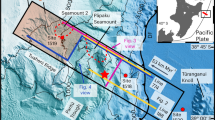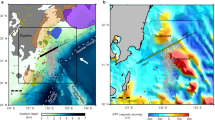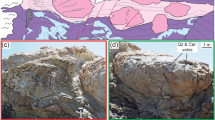Abstract
Tectonic erosion of the overriding plate by the downgoing slab is believed to occur at half the Earth’s subduction zones1,2. In situ investigation of the geological processes at active erosive margins is extremely difficult owing to the deep marine environment and the net loss of forearc crust to deeper levels in the subduction zone. Until now, a fossil erosive subduction channel—the shear zone marking the plate boundary3—has not been recognized in the field, so that seismic observations have provided the only information on plate boundary processes at erosive margins. Here we show that a fossil erosive margin is preserved in the Northern Apennines of Italy. It formed during the Tertiary transition from oceanic subduction to continental collision, and was preserved by the late deactivation and fossilization of the plate boundary. The outcropping erosive subduction channel is ∼500 m thick. It is representative of the first 5 km of depth, with its deeper portions reaching ∼150 °C. The fossil zone records several surprises. Two décollements were simultaneously active at the top and base of the subduction channel. Both deeper basal erosion and near-surface frontal erosion occurred. At shallow depths extension was a key deformation component within this erosive convergent plate boundary, and slip occurred without an observable fluid pressure cycle. At depths greater than about 3 km a fluid cycle is clearly shown by the development of veins and the alternation of fast (co-seismic) and slow (inter-seismic) slip. In the deepest portions of the outcropping subduction channel, extension is finally overprinted by compressional structures. In modern subduction zones the onset of seismic activity is believed to occur at ∼150 °C, but in the fossil channel the onset occurred at cooler palaeo-temperatures.
This is a preview of subscription content, access via your institution
Access options
Subscribe to this journal
Receive 51 print issues and online access
$199.00 per year
only $3.90 per issue
Buy this article
- Purchase on Springer Link
- Instant access to full article PDF
Prices may be subject to local taxes which are calculated during checkout



Similar content being viewed by others
References
Clift, P. & Vannucchi, P. Controls on tectonic accretion versus erosion in subduction zones: Implications for the origin and recycling of the continental crust. Rev. Geophys. 42 RG2001 10.1029/2003RG000127 (2004)
von Huene, R. & Scholl, D. W. Observations at convergent margins concerning sediment subduction, subduction erosion, and the growth of continental-crust. Rev. Geophys. 29, 279–316 (1991)
Cloos, M. & Shreve, R. L. Subduction-channel model of prism accretion, mélange formation, sediment subduction, and subduction erosion at convergent plate margins: 1. Background and description. Pure Appl. Geophys. 128, 455–500 (1988)
von Huene, R., Ranero, C. R. & Vannucchi, P. Generic model of subduction erosion. Geology 32, 913–916 (2004)
Hilde, T. W. C. Sediment subduction versus accretion around the Pacific. Tectonophysics 99, 381–397 (1983)
Dominguez, S., Malavieille, J. & Lallemand, S. E. Deformation of accretionary wedges in response to seamount subduction: Insights from sandbox experiments. Tectonics 19, 182–196 (2000)
Le Pichon, X., Henry, P. & Lallemant, S. Accretion and erosion in subduction zones: The role of fluids. Annu. Rev. Earth Planet. Sci. 21, 307–331 (1993)
Bilek, S. L. & Lay, T. Rigidity variations with depth along interplate megathrust faults in subduction zones. Nature 400, 443–446 (1999)
Sage, F., Collot, J. Y. & Ranero, C. R. Interplate patchiness and subduction–erosion mechanisms: Evidence from depth-migrated seismic images at the central Ecuador convergent margin. Geology 34, 997–1000 (2006)
Sibson, R. H. Frictional constraints on thrust, wrench and normal faults. Nature 249, 542–544 (1974)
Segall, P. & Rice, J. R. Dilatancy, compaction, and slip instability of a fluid-infiltrated fault. J. Geophys. Res. 100, 22155–22171 (1995)
Remitti, F., Bettelli, G. & Vannucchi, P. Internal structure and tectonic evolution of an underthrust tectonic mélange: the Sestola–Vidiciatico tectonic unit of the Northern Apennines, Italy. Geodin. Acta 20, 37–51 (2007)
Plesi, G. Foglio 235 Pievepelago e Note illustrative della carta geologica d’Italia alla scala 1:50.000. (S.EL.CA., Firenze, 2002)
Landuzzi, A. Relationships between the Marnoso–Arenacea formation of the Inner Romagna Units and the Ligurids (Italy). Mem. Soc. Geol. Ital. 48, 523–534 (1994)
Cibin, U., Spadafora, E., Zuffa, G. G. & Castellarin, A. Continental collision history from arenites of episutural basins in the Northern Apennines, Italy. Geol. Soc. Am. Bull. 113, 4–19 (2001)
Amorosi, A. Miocene shallow-water deposits of the northern Apennines: A stratigraphic marker across a dominantly turbidite foreland-basin succession. Geol. Mijnbouw 75, 295–307 (1996)
Reches, Z. Faulting of rocks in three-dimensional strain fields. II. Theoretical analysis. Tectonophysics 95, 133–156 (1983)
Healy, D., Jones, R. R. & Holdsworth, R. E. Three-dimensional brittle shear fracturing by tensile crack interaction. Nature 439, 64–67 (2006)
Moore, J. C. & Byrne, T. Thickening of fault zones: A mechanism of melange formation in accreting sediments. Geology 15, 1040–1043 (1987)
Sibson, R. H. Conditions for fault-valve behaviour. Geol. Soc. Spec. Publ. 54, 15–28 (1990)
Sibson, R. H. Implications of fault-valve behavior for rupture nucleation and recurrence. Tectonophysics 18, 1031–1042 (1992)
Reutter, K. J., Heinitz, I. & Eusslin, R. Structural and geothermal evolution of the Modino–Cervarola Unit. Memorie Carta Geologica d’Italia 46, 257–266 (1992)
Zattin, M., Landuzzi, A., Picotti, V. & Zuffa, G. G. Discriminating between tectonic and sedimentary burial in a foredeep succession, Northern Apennines. J. Geol. Soc. Lond. 157, 629–633 (2000)
Obana, K. et al. Microseismicity at the seaward updip limit of the western Nankai Trough seismogenic zone. J. Geophys. Res. 108 10.1029/2002JB002370 (2003)
Moore, J. C. & Saffer, D. Updip limit of the seismogenic zone beneath the accretionary prism of southwest Japan: An effect of diagenetic to low-grade metamorphic processes and increasing effective stress. Geology 29, 183–186 (2001)
Sibson, R. H. Controls on low-stress hydrofracturing dilatancy in thrust, wrench and normal fault terrains. Nature 289, 665–667 (1981)
Bangs, N. L. B., Gulick, S. P. S. & Shipley, T. H. Seamount subduction erosion in the Nankai Trough and its potential impact on the seismogenic zone. Geology 34, 701–704 (2006)
Harris, R. N. & Wang, K. Thermal models of the middle America trench at the Nicoya Peninsula, Costa Rica. Geophys. Res. Lett. 29 10.1029/2002GL015406 (2002)
Ranero, C. R., Weinrebe, W., Grevemeyer, I., von Huene, R. & Reichert, C. The relation between tectonics, fluid flow and seismogenesis at convergent erosional margins. Eos Trans. AGU 85, Fall Meet. Suppl. Abstract S43D–01 (2004)
Acknowledgements
We thank J. P. Morgan for discussions and G. Ruggeri for sharing preliminary results on fluid inclusion analysis. This work is a contribution to PRIN ‘Dynamics in subduction complexes: mass transfer in fossil systems and comparison with modern examples’.
Author Contributions All authors participated in collecting the data, interpretation of results and developing the model. P.V. wrote the paper. G.B. conceived the project.
Author information
Authors and Affiliations
Corresponding author
Supplementary information
Supplementary Notes
The file contains Supplementary Notes with additional references. (PDF 249 kb)
Rights and permissions
About this article
Cite this article
Vannucchi, P., Remitti, F. & Bettelli, G. Geological record of fluid flow and seismogenesis along an erosive subducting plate boundary. Nature 451, 699–703 (2008). https://doi.org/10.1038/nature06486
Received:
Accepted:
Issue Date:
DOI: https://doi.org/10.1038/nature06486
This article is cited by
-
A strength inversion origin for non-volcanic tremor
Nature Communications (2022)
-
Insights into the Porretta Terme (northern Apennines, Italy) hydrothermal system revealed by geochemical data on presently discharging thermal waters and paleofluids
Environmental Geochemistry and Health (2022)
-
Early–Middle Jurassic metamorphic and non-metamorphic supra-subduction zone ophiolite fragments in a Late Cretaceous ophiolitic mélange (northern Turkey): implications for long-lived and supra-subduction zone ophiolite formation
International Journal of Earth Sciences (2022)
-
Neogene tectonic evolution of the Misis-Andırın-Engizek range: structural and sedimentary evidences from Bulgurkaya Sedimentary Mélange
Arabian Journal of Geosciences (2021)
-
The study of subduction channels: Progress, controversies, and challenges
Science China Earth Sciences (2020)
Comments
By submitting a comment you agree to abide by our Terms and Community Guidelines. If you find something abusive or that does not comply with our terms or guidelines please flag it as inappropriate.



